End of Period [U04]: Interactive Updates
 This is part of the End of Period [U04]
group. For an introduction to End of Period and links to all the End of Period documents, refer to
End of Period [U04]: Overview.
This is part of the End of Period [U04]
group. For an introduction to End of Period and links to all the End of Period documents, refer to
End of Period [U04]: Overview.
- Submit [U0401]
- Status Review [U0402]
- Status Listing [U0403]
- Halt/Restart/Skip [U0404]
- Restart [U0405]
- Print/View Reports [U0406]
Introduction
End of Period includes a group of interactive updates that can be used to submit, monitor, and administrate End of Period through the LeasePak client.
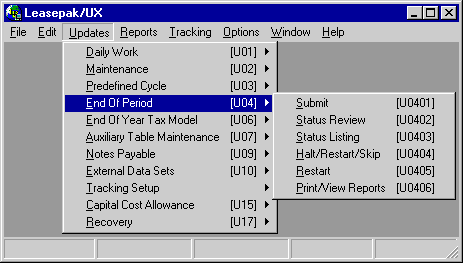
These updates can be accessed through the LeasePak Updates menu, End of Period option or by entering the updates' respective menu numbers into Fast Menu <F2>.
Option Descriptions
- Submit
[U0401]
The Submit update [U0401] is the first step in starting an End of Period (EOP) process. This update should be selected when the books for the day, month, and/or year are ready to be closed. The EOP process is executed separately for each portfolio, although all portfolios may be submitted at once through this update.
- Status Review
[U0402]
The End of Period Status Review [U0402] shows the overall status of End of Period (EOP) process(es), separated by portfolio. This report may be used to monitor the status of any or all EOP processes while they are executing or to verify that EOP has completed.
- Status
Listing [U0403]
The End of Period Status Listing [U0403] shows current status for each module. It is useful when determining the impact of halting a module or skipping a failed module.
- Halt/Restart/Skip
[U0404]
The Halt/Restart/Skip update [U0404] controls the End of Period batch queue. It may be used to:
- stop execution of an End of Period module (HALT)
- resubmit a stopped module (RESTART)
- skip
over any incomplete module entirely (SKIP)
- Restart
[U0405]
The Restart update [U0405] resubmits a stopped module (or modules) to the End of Period batch queue. A stopped module may have been stopped intentionally by a supervisor or may have failed due to some program error or external circumstance (e.g., power failure).
- Print/View
Reports [U0406]
The Print/View Reports update [U0406] offers immediate access to reports which reveal the results of End of Period processes. One portfolio's reports may be viewed or printed at a time.
Submit [U0401]
The Submit update [U0401] is the first step in starting an End of Period (EOP) process. This update should be selected when the books for the day, month, and/or year are ready to be closed. The EOP process is executed separately for each portfolio, although all portfolios may be submitted at once through this update.
A normal EOP process is composed of several steps:
- EOP is submitted to a batch queue for later execution by a designated LeasePak operator
at the close of the day, month and/or year, using the Submit update [U0401].
- Data files and other applicable files are backed up by a system operator.
- The administrator will usually have set EOP to begin processing after backups are completed. EOP automatically submits a batch job for each of the modules (updating/reporting) scheduled to perform. These batch jobs may be executed in parallel to better use the system's resources.
Notes:
Most LeasePak tracking modules should not be used while the EOP process [U0401] is executing, because EOP may change information about lessees, assets, and/or leases tracked. Accurate information would not be reflected in the tracking module used at the same time. The tracking module updates affected include:
U1101 Collection
U1601 Customer Service
U1201 Collateral
U1401 Maturing Lease
If tracking modules are purchased, all staff must exit the above updates before EOP begins executing. They may re-enter these updates when the EOP process is completed.
The Collection Initialization module, which is responsible for assigning and reassigning delinquent lessees to collectors, is not executed for each individual portfolio. It is executed once, after all submitted portfolios have completed processing. It is executed by the EOP End module [U0499] of the last portfolio to complete processing. If the Collection module is purchased, then portfolios may not be submitted for EOP with the Submit update [U0401] while the Collection Initialization module is executing. If the Collection Initialization module is going to be run during an EOP, then the End of Day Sequential Updates module [U0411] should be executed for all portfolios. Refer to the description of the EOP End module [U0499] for more information.
If the Batch Payments module is purchased and an input file of payments will be downloaded during EOP, a preliminary step is necessary before EOP is submitted. LEASE/UTIL 111 must be executed at the $ prompt from a supervisor's account. It may be executed before EOP begins, while users are still on the system. This utility sorts the payment input file by P/C/R/O so it can be efficiently processed by the EOP Batch Payment update [U0415]. It also creates a table of exception items that could not be processed.
The 1999 JULE Fund module will allow LeasePak the ability to accrue and invoice up to the actual month end when End of month is submitted prior to the actual month end date. LeasePak will allow a five day window to submit EOM.

This screen is used to select the portfolio(s) for which EOP is to be submitted. For convenience, all portfolios may be submitted at once. However, each portfolio is processed independently.
If the Multi-portfolio Security module is purchased, only users with unrestricted access may submit ALL. Users restricted to selected portfolios must submit EOP individually for each of the portfolios they may access. A message to that effect will display if ALL is selected.
If only one portfolio is available (i.e., the Multi-portfolio module is not purchased), that portfolio number displays and the user should press Return to continue.
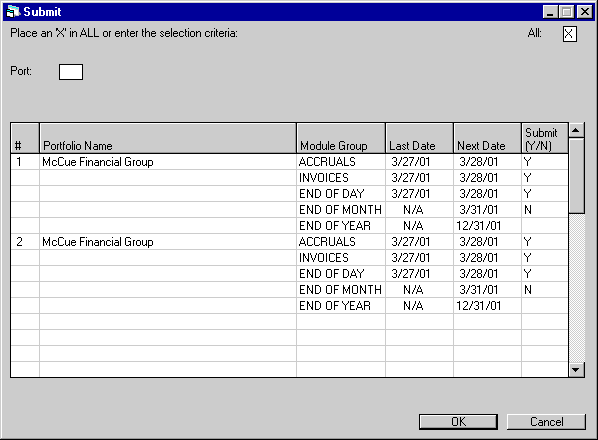
This screen is used to select which EOP groups to submit. It appears if there are no updates in process for the portfolio(s) to be submitted. For every group in EOP (accruals, invoicing, end of day, month, and year), each portfolio to be submitted is displayed.
An EOP group is scheduled to execute if the NEXT DATE is on or before the current date. If any group is scheduled to execute, a default of Y is placed in the SUBMIT field. The user may change this to N if the group should not be submitted.
If Accruals and/or Invoicing were skipped for several days, the NEXT DATE shown is the first date they were skipped. When finally submitted, the accrual and/or invoicing process catches up all missed cycles as long as a full month has not passed. Scheduling accrual and invoicing cycles is controlled through the Predefined Cycles Customization option of the Portfolio update [U0212].
Field Descriptions
- SUBMIT
(Y/N) (scrolled area)
Enter Y to submit the process. Otherwise, enter N. If the field is blank, the process is not scheduled to execute at this time and entry of Or N is not permitted.
If all modules in an EOP group are set to N through the MODULES AND REPORTS screen of the EOP Customizations option of the Portfolio update [U0212], this field is blank and may not be accessed, regardless of NEXT DATE. If the process is to be executed, each module set to run must be coded Y through the EOP Customizations option of the Portfolio update [U0212].
If there are outstanding accruals and the Accrual process is not submitted, the field next to the Invoicing process is blank and may not be accessed. Invoicing may not be executed when outstanding accruals exist.
The Accrual and Invoicing processes may be submitted without submitting the End of Day process. If this is done, a warning message is displayed to the effect that submitting Accruals or Invoicing without End of Day may cause report discrepancies. For example, if End of Day is run later, the Daily Transaction Journal [R0405] and the G/L Entries Listing [R0406] do not show the previously run Accrual transactions.
During the 5 days before the actual end of month, a default of N is placed in the SUBMIT field for End of Month. The user is allowed to change the SUBMIT to Y, thereby submitting End of Month early. If End of Month is executed early, the books are closed as of the date of execution, not the actual end of the month. For example, if End of Month for August is submitted on August 30th, the books are closed as of August 30th, not August 31st.
With the purchase of the 1999 JULE Fund module, LeasePak will perform all accruals and invoices ahead of the actual month end date when EOM is submitted within the five day window based on the LAST DAY OF THE MONTH entered in Miscellaneous Customization option of the Portfolio update [U0212]. For example, if End of Month for August is submitted on the 26th, accrual and invoicing will be processed for leases from the 27th through the 31st. This enhancement will only apply to accruals and invoicing processed through End of Month.Note: This functionality does not apply to Cycle Accrual [U0301]and Cycle Invoicing [U0302] processes, i.e. if Cycle Accrual [U0301] is submitted on the 26th, leases with the 27th through 31st will not be picked up until the following month.
End of Year is automatically submitted with the End of Month process for the fiscal year end. For example, if the fiscal end of year is 6/30, End of Year is automatically submitted when the End of Month for June is submitted.

This screen is used to specify the submit status and the starting check numbers if cashier's checks and/or the check register are to be generated during this EOP process. More detail on statuses is found in the End of Period [U04]: Overview.
Field Descriptions
- BEGINNING
CHECK NUMBER
If cashier's checks and/or the check register are to be produced for the portfolio, enter the starting check number. The check number is significant if LeasePak is used to format and print checks on pre-numbered check forms.
- EXECUTE
TIME (I/H/A)
This field defaults to the status entered on the first screen of the EOP Customizations option of the Portfolio update [U0212]. Change, if desired, the submit status for each portfolio to one of the following.
- I Begin executing the EOP process for this portfolio immediately.
- H Place this EOP process on the EOP batch queue in a hold status.
- A
Place this EOP process on the EOP batch queue in a wait status. It begins
executing at the EXECUTE TIME specified.
- EXECUTE
TIME
If the EOP process is submitted in an "after" status, enter or change the time at which to begin executing EOP. This field is defaulted with the execute time entered on the first screen of the EOP Customizations option of the Portfolio update [U0212].
There are 2 valid time formats that may be used to specify a time:
- absolute time, which specifies an actual date and/or time
- delta
time, which specifies a date and time in the future, calculated from the current
date and time
Absolute time is similar to an alarm clock setting. Delta time is similar to an egg timer setting.
The formats of these 2 times are:
Absolute Time dd-mmm-yyyy hh:mm:ss.cc (e.g., -- 23:00)
Delta Time dddd hh:mm:ss.cc (e.g., 0 01:00)Either time may be abbreviated, but hyphens and spaces are required.
For more information and examples, refer to Time Formats in the EOP Customizations option of the Portfolio update [U0212].
An absolute AFTER TIME between midnight (00:00) and 8:00 am (08:00) causes LeasePak to submit EOP to begin executing the next day at the specified time. Any other time causes LeasePak to begin executing today at the specified time. For example, if EOP is submitted on Monday at 5:00 pm with an absolute AFTER TIME of 23:00, it begins executing on Monday at 11:00 pm. If it is submitted with an absolute AFTER TIME of 02:00, it begins executing on Tuesday at 2:00 am. If EOP is submitted on Monday at 6:00 am with an absolute AFTER TIME of 7:00 am, it begins executing on Tuesday at 7:00 am.
Note: When submitting an End of Period using delta time i.e. (--19:00) the actual start of the End of Period does not correspond to the time entered in the EOP Customizations option of the Portfolio update [U0212].
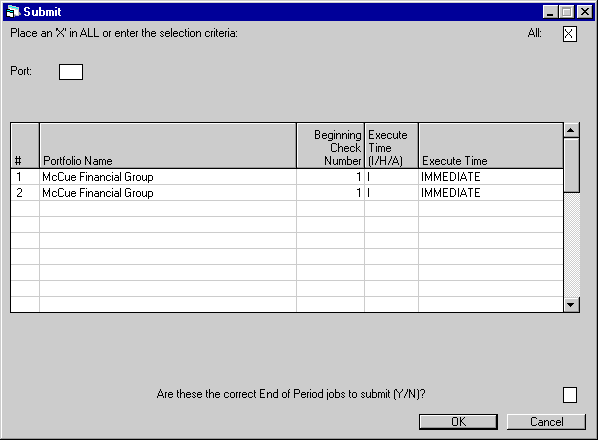
This screen is used to verify that these are the correct EOP jobs to submit.
Field Descriptions
- ARE
THESE THE CORRECT END OF PERIOD JOBS TO SUBMIT (Y/ N)?
Enter Y to submit the EOP jobs. Enter N to cancel the submit process.
If the Collection Initialization program is currently executing, a warning message will be displayed and the submit process will be cancelled.
If EOP jobs are submitted, the message BATCH JOB SUBMITTED is displayed once for every EOP job (i.e., once for each portfolio whose EOP process is submitted). Therefore, the message may appear to flicker on the screen; it is actually being displayed multiple times.
Status Review [U0402]
The End of Period Status Review [U0402] shows the overall status of End of Period (EOP) process(es), separated by portfolio. This report may be used to monitor the status of any or all EOP processes while they are executing or to verify that EOP has completed. Information reported is:
- last and next execution dates for each of the 5 component processes of EOP (accruals, invoicing, End of Day, End of Month, and End of Year);
- which of the 5 processes are currently executing;
- whether updates for the portfolio are locked or unlocked;
- the number of modules in any one of 13 statuses (for explanations of each status, refer to documentation for End of Period Overview); and
- list of modules scheduled to execute this EOP, their current status and their job name on the batch queue.
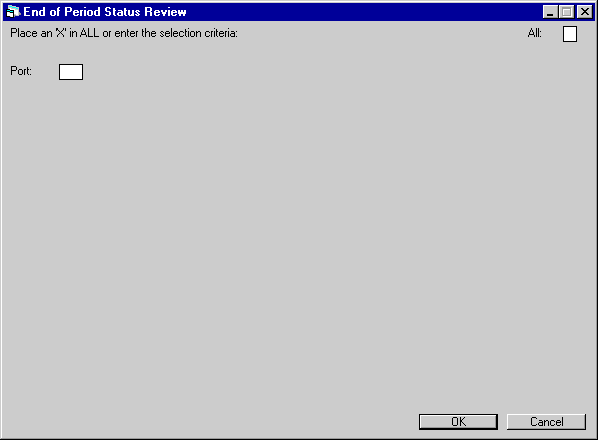
This screen is used to select the portfolio(s) on which the End of Period Status Review should report.
Field Descriptions
- ALL
Enter X to report on all portfolios. Leave blank to report on a specific portfolio.
- PORT
Enter the number of the portfolio upon which to report. Leave blank to report on all portfolios.
End of Period Status Review

The End of Period Status Review [U0402] reports on End of Period modules and includes the following information:
- MODULE
GROUP
Each of the 5 possible components of EOP is listed (Accruals, Invoicing, End of Day, End of Month, End of Year).
- LAST
DATE
For each of the 5 components of EOP, the last date of execution as scheduled is displayed MM/DD/YY or DD/MM/YY format, depending on the Date Format Preference field in Security [U0706].
- NEXT
DATE
For each of the 5 components, the next currently scheduled execution date is displayed MM/DD/YY or DD/MM/YY format, depending on the Date Format Preference field in Security [U0706].
- <current>
The word <current> appears next to components which are currently executing.
- INTERACTIVE UPDATE STATUS
The interactive update status may be either:
- LOCKED
Interactive updates may not be performed for this portfolio. EOP has not completed for the portfolio.
- UNLOCKED
Interactive updates may be performed for this portfolio. There is no current EOP processing for the portfolio.
- #
MODULES
The number of modules in each EOP module status listed is displayed.
- MODULES
SUBMITTED, STATUS SUMMARY AS OF
The EOPeriod statuses for modules are listed here. Also displayed are the date that EOP was submitted by the operator and the date and time of this status summary. Refer to the End of Period Overview document for a detailed description of statuses and their meanings.Note: This report reflects module statuses at the displayed STATUS SUMMARY AS OF date and time only. This report is not automatically changed when status of a module changes. For a current status, recreate the report. Do not assume that a previously generated report shows the current status of EOP modules.
- MODULE
NAME
Each module scheduled to execute during this EOP is listed. Individual modules that are part of sequential updates do not appear. The overall status of Sequential Updates appears instead.
- GROUP
The abbreviation of the group to which each module belongs is displayed (e.g., ACC = Accruals, INV = Invoicing, DAY = End of Day, etc.).
- CURRENT
STATUS
The current status of each module is displayed.
- JOB
NAME
The job name, as it appears on the EOP batch queue, is displayed. The portfolio number is included as part of the job name.
The job name is useful in relating the LeasePak modules with actual jobs on the EOP batch queue.
Status Listing [U0403]
The End of Period Status Listing [U0403] shows current status for each module. It is useful when determining the impact of halting a module or skipping a failed module.
Information reported is:
- current module status;
- start and end dates and times for the module, if applicable;
- job name as it appears on the End of Period batch queue;
- a list of parent modules to this module, including their current statuses and job names; and
- a list of dependent modules to this module, including their current status and job names.
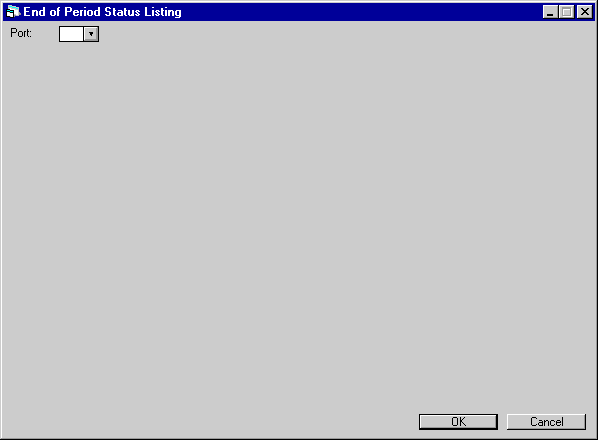
This screen is used to select the portfolio on which the End of Period Status Listing should report.
Field Descriptions
- PORT
Enter the number of the portfolio on which to report.
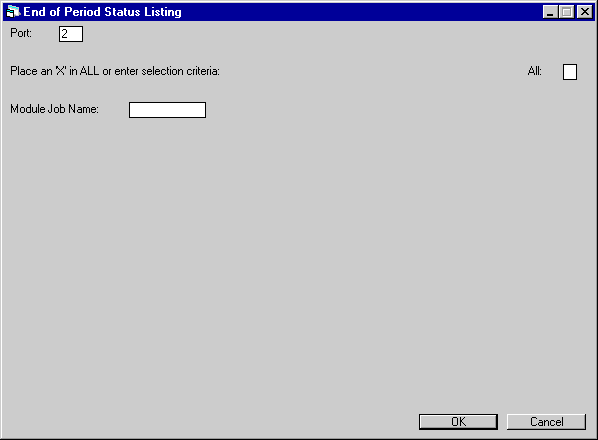
This screen is used to select the module(s) on which to report.
Field Descriptions
- ALL
Enter X to report on all modules. Leave blank to report on a specific module.
- MODULE
JOB NAME
Enter the job name of the specific module on which to report. Leave blank if reporting on all modules. Use Help for a list of valid module job names and their descriptions.
End of Period Status Listing

The End of Period Status Listing [U0403] reports on End of Period modules and includes the following information:
- MODULE
The name of the module is displayed. For purposes of the following field descriptions, this module is referred to as MODULE.
Individual modules that are part of sequential updates do not appear. The overall status of Sequential Updates appears instead.
- GROUP
The abbreviation of the group to which MODULE belongs (e.g., ACC = Accruals, INV = Invoicing, DAY = End of Day, etc.) is displayed.
- CURRENT
STATUS
The current status of MODULE is displayed. Refer to the End of Period Overview for a detailed description of different statuses and their meanings.
- START
DATE
The date MODULE started executing is displayed. If MODULE has not yet started, N/A is displayed.
- START
TIME
The time MODULE started executing is displayed depending on the Date Format Preference field in Security [U0706]. If MODULE has not yet started, N/ A is displayed.
- END
DATE
The date on which MODULE finished executing is displayed. If MODULE has not yet finished, N/A is displayed.
- END
TIME
The time at which MODULE finished executing is displayed. If MODULE has not yet finished, N/A is displayed.
- JOB
NAME
The name of the batch job for this MODULE, as it appears on the EOP batch queue, is displayed.
- PARENT
MODULES -- WHICH MUST BE COMPLETED, RESTARTED OR SKIPPED
A list of all parent modules to this module is displayed. All parent modules must complete successfully or be skipped before this MODULE may begin. A parent module is defined as another module which updates the same files as required by this MODULE, and which must successfully finish before this MODULE may start.Note: Information related to parent modules is not shown for skipped or completed modules, or for modules with no parents.
- GRP
(PARENT MODULES)
The abbreviation of the group to which the parent module belongs (e.g., ACC = Accruals, INV = Invoicing, DAY = End of Day, etc.) is displayed.
- CURRENT
STATUS (PARENT MODULES)
The current status of the parent module is displayed. Refer to the End of Period Overview for a detailed description of different statuses and their meanings.
- JOB
NAME (PARENT MODULES)
The name of the batch job for the parent module, as it appears on the EOP batch queue, is displayed.
- DEPENDENT
MODULES -- WHICH MUST WAIT BEFORE STARTING
A list of all dependent modules to this MODULE is displayed. A dependent module is defined as another module which uses and/or updates the same files as required by this MODULE, and which must wait until this MODULE successfully completes before starting.Note: Information related to dependent modules is not shown for skipped or completed modules, or for modules with no dependent modules.
- GRP
(DEPENDENT MODULES)
The group to which the dependent module belongs (Accruals, Invoicing, End of Day, End of Month, End of Year) is displayed.
- CURRENT
STATUS (DEPENDENT MODULES)
The current status of the dependent module is displayed. Refer to the End of Period Overview for a detailed description of different statuses and their meanings.
- JOB
NAME (DEPENDENT MODULES)
The name of the batch job for the dependent module, as it appears on the EOP batch queue, is displayed.
Halt/Restart/Skip [U0404]
The Halt/Restart/Skip update [U0404] controls the End of Period batch queue. It may be used to:
- stop execution of an End of Period module (HALT)
- resubmit a stopped module (RESTART)
- skip over any incomplete module entirely (SKIP)
If not performed properly, skipping modules may cause problems, including corrupted data. Therefore, before skipping a module, obtain a clear understanding of what the module does, especially analyzing any effects on its "children". For example, skipping an accrual cycle but continuing with the invoicing process causes the Invoicing update to invoice leases that have not been updated for the current billing month. In this case, both the accrual and invoicing processes should be skipped. Skipping other updates, such as the Vendor File Clean-up, does not have any adverse effect.
The Restart update [U0405] is a subset of the Halt/Restart/Skip update [U0404]. The Restart update [U0405] is designed for operators who may need to restart End of Period, but who are not responsible for determining whether modules may be halted or skipped. In general, security for users should be set so that neither of the 2 updates [U0404] or [U0405] is allowed, or only one is allowed, but not both.
For example, if there is a power failure while End of Period was executing, the End of Period process must be restarted after power is restored. This may be performed by any user with the security to enter the Restart update [U0405], and does not require the additional authority for the Halt/Restart/ Skip update [U0404]. However, if a module of End of Period failed due to another type of error, a supervisor or someone familiar with LeasePak and its processes would be needed to restart End of Period with the Halt/ Restart Skip update [U0404]. This person must determine whether the module should be restarted or skipped and recovered.
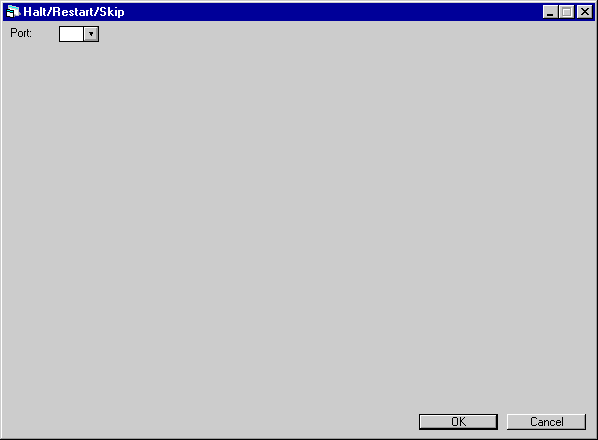
This screen is used to enter the portfolio of the module to be halted, restarted, or skipped.

This screen is used to specify the batch queue status changes (i.e., halting, restarting or skipping) for the End of Period modules of the portfolio selected. The name of the portfolio is displayed and should be verified as correct before making any changes.
Note: The CURRENT STATUS displayed for each module is valid only for the CURRENT STATUS AS OF date and time displayed in MM/DD/YY or DD/MM/YY format, depending on the Date Format Preference field in Security [U0706]. To view the up-to-the-minute status, cancel back to screen 1 of this update and re-enter this screen.
Field Descriptions
- HALT/RESTART/SKIP
ALL MODULES (H/R/S)
Enter H to halt all incomplete modules, R to restart all stopped modules, or S to skip all incomplete modules. Leave blank if specific modules are to be halted, restarted, or skipped.
This field may be used to enter the desired batch queue change (halt, restart, or skip) for most applicable modules. Once a selection is entered, the user may tab to individual modules and change their specific settings. For example, if all modules are to be restarted except a failed module which is to be skipped, enter R in this field. Press TAB and an R appears next to all applicable modules in the module list. Tab to the failed module and change the displayed R to S.
The status changes are:
- HALT A
halted module is stopped and taken off the batch queue. If it was currently processing,
no data file recovery is automatically performed. All dependent modules which
are waiting for the halted module to complete before beginning are also postponed
and taken off the queue. End of Period cannot be completed if halted modules exist.
The halted modules must either be restarted or skipped.
Only modules with the following statuses may be halted:
HOLDING ON QUEUE
HOLDING ON QUEUE - WAITING BACKUPS
TIMED FOR LATER EXECUTION
CURRENTLY IN PROGRESS
PENDING COMPLETION OF PARENT MODULE
PENDING INITIALIZATION
PENDING STARTUP OF QUEUE
A halt of all modules merely takes the modules off the batch queue. It does not complete the End of Period process and it does not unlock updates (i.e., interactive updating is still disallowed).
- RESTART
A restarted module recovers the data files modified by the previous (unsuccessful)
execution of the module, and starts the module from the beginning. If a module
failed due to an error, the cause of the failure must be determined and corrected
before restarting the module.
Only modules with the following statuses may be restarted:
FAILED DUE TO ERROR
HALTED BY SUPERVISOR
POSTPONED - PARENT MODULE FAILED
POSTPONED - PARENT MODULE HALTED
A restart of all modules restarts all necessary End of Period modules needed to complete End of Period. This is often an easy and safe way to restart End of Period. However, failed modules may require a correction of some type before they can successfully finish.
- SKIP A
skipped module is a module that is scheduled to execute but is not executed during
this End of Period process. If the module is currently processing, it is stopped.
The module is considered completed so that any dependent modules that are postponed
or pending completion of the skipped parent module may proceed, as if the skipped
module completed successfully. Any module which is not completed or already skipped
may be skipped.
Note: To skip module 1 (which is currently in progress) and all its dependents (which are pending), skip module 1's dependents at the same time as module 1 is skipped, to ensure that the dependents don't start immediately after module 1 is skipped.
A skip of all modules halts all non-completed modules and unlocks the updates, thus allowing interactive updating. End of Period is stopped at whatever stage it currently is processing. Although the last end of period dates are unchanged (as if the End of Period were never submitted), it is important to note that some modules may have already been completed (i.e., some updates may have processed successfully) for the skipped End of Period. If this is not desired, restore the backups of the database made immediately prior to starting End of Period.
- HALT A
halted module is stopped and taken off the batch queue. If it was currently processing,
no data file recovery is automatically performed. All dependent modules which
are waiting for the halted module to complete before beginning are also postponed
and taken off the queue. End of Period cannot be completed if halted modules exist.
The halted modules must either be restarted or skipped.
- HALT/RESTART/SKIP (H/R/S)
Enter H to halt an incomplete module, R to restart a stopped module, or S to skip a pending module. Leave blank if no change is desired. If an entry to HALT/RESTART/SKIP ALL MODULES is made, all applicable modules are defaulted with that entry value. These defaults may be changed for specific modules by tabbing to the desired module and changing the default value. Refer to the field HALT/RESTART/SKIP ALL MODULES for more information.
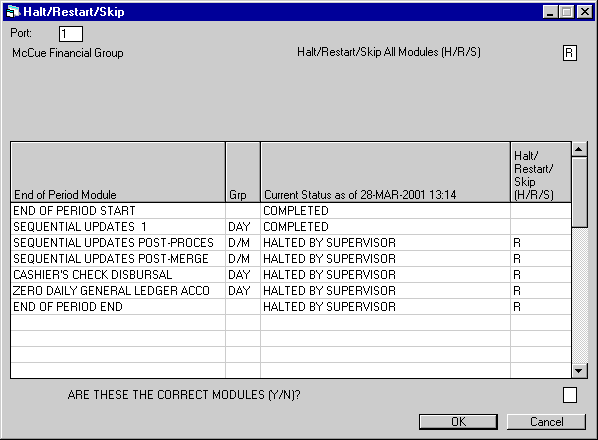
This screen is used to verify that the batch queue changes entered on the previous screen are correct.
Field Descriptions
- ARE
THESE THE CORRECT MODULES (Y/N)?
Enter Y to perform the batch queue changes indicated. Enter N if the batch queue changes should not be done. If restarting modules and Y is entered, when ENTER is pressed, the message "Batch job submitted" is displayed once for each module resubmitted to the batch queue (the message appears to be flashing on the screen as it is redisplayed several times).
Restart [U0405]
The Restart update [U0405] resubmits a stopped module (or modules) to the End of Period batch queue. A stopped module may have been stopped intentionally by a supervisor or may have failed due to some program error or external circumstance (e.g., power failure).
The Restart update [U0405] is a subset of the Halt/Restart/Skip update [U0404]. The Restart update [U0405] is designed for operators who may need to restart End of Period, but who are not responsible for determining whether modules may be halted or skipped. In general, security for users should be set so that neither of the 2 updates [U0404] or [U0405] is allowed, or only one is allowed, but not both.
For example, if there is a power failure while End of Period was executing, the End of Period process must be restarted after power is restored. This may be performed by any user with the security to enter the Restart update [U0405], and does not require the additional authority for the Halt/Restart/ Skip update [U0404]. However, if a module of End of Period failed due to another type of error, a supervisor or someone familiar with LeasePak and its processes would be needed to restart End of Period with the Halt/ Restart/Skip update [U0404]. This person must determine whether the module should be restarted or skipped and recovered.
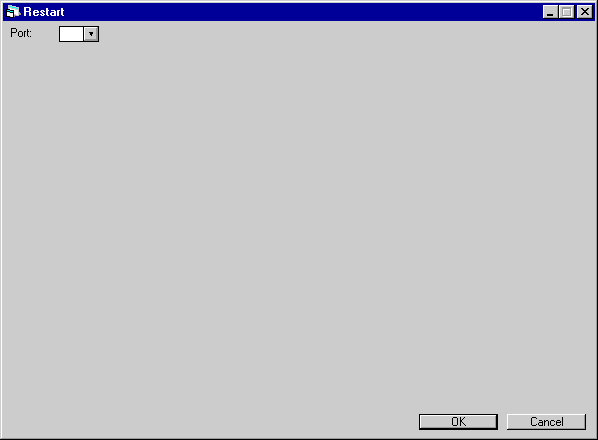
This screen is used to enter the portfolio of the module to be restarted.
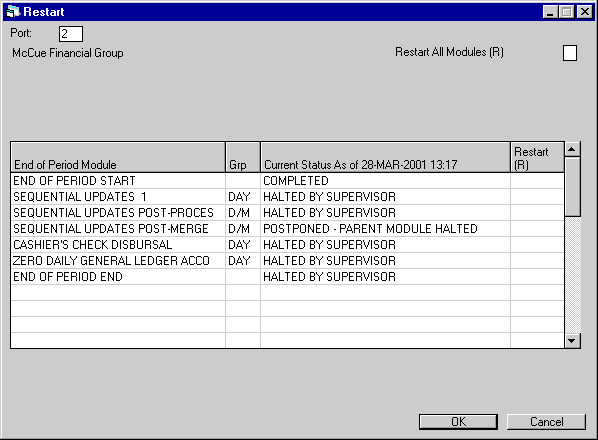
This screen is used to specify the End of Period modules to be restarted for the portfolio selected. The name of the portfolio is displayed and should be verified as correct before making any changes.
Field Descriptions
- RESTART
ALL MODULES (R)
Enter R to restart all stopped modules. Leave blank if specific modules should be restarted.
This field may be used to quickly restart all applicable modules. Once R is entered, the user may tab to individual modules and clear the R for those modules which should not be restarted. For example, if all modules are to be restarted except for one, enter R in this field. Press TAB and an 'R' appears next to all applicable modules in the module list. Tab to the one module not to be restarted and change the defaulted R to a blank.
A restarted module recovers the data files modified by the previous, unsuccessful execution of the module, and starts the module from the beginning. Only modules with the following statuses may be restarted:
FAILED DUE TO ERROR
HALTED BY SUPERVISOR
POSTPONED - PARENT MODULE FAILED
POSTPONED - PARENT
MODULE HALTED
A restart of all modules restarts all necessary End of Period modules to complete End of Period. This is often an easy and safe way to restart End of Period. However, failed modules may require a correction of some type before they can successfully finish.
- RESTART
(R)
Enter R to restart a stopped module. Leave blank if the module should not be restarted. If R is entered for the RESTART ALL MODULES field, all applicable modules are defaulted with R. These defaults may be changed for specific modules by moving to the desired module and clearing the defaulted R.
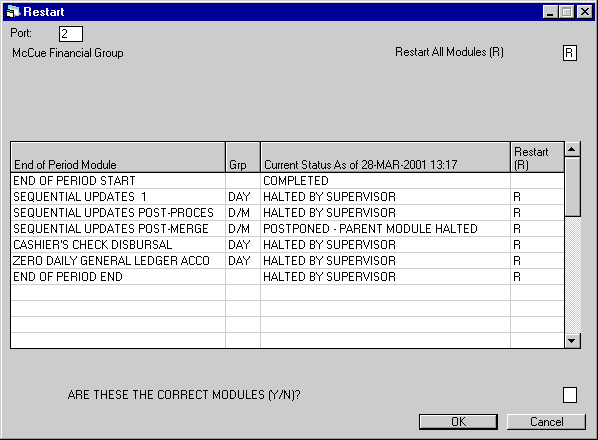
This screen is used to verify that the list of modules to be restarted, as entered on the previous screen, is correct.
Field Descriptions
- ARE
THESE THE CORRECT MODULES (Y/N)?
Enter Y to restart the selected modules. If Y is entered, when ENTER is pressed, the message "Batch job submitted" is displayed once for each module resubmitted to the batch queue (The message may appear to be flashing on the screen as it is redisplayed several times.)
Print/View Reports [U0406]
The Print/View Reports update [U0406] offers immediate access to reports which reveal the results of End of Period processes. One portfolio's reports may be viewed or printed at a time.
When parameters are established for portfolios on the End of Period Customization option of the Portfolio update [U0212], the user designates which reports will print, how many copies, etc. The on-line Print/Review Reports update [U0406] allows a user to access a report not designated for printing on [U0212], or to view reports on line as soon as End of Period is complete.
Note: Considerable time may be required to run a requested report and display it on the screen.

The next screen is a menu of the reports or groups of reports which may be produced with this update.
Field Descriptions
- ALL
Select this option to produce all reports on the menu.
- CYCLE
ACCRUALS
Select this option to produce one or more of the 4 audit reports generated from accruals processing. They are:
- Precomputed Income Accrual Register [U0301A]
- Simple Interest Accrual Register [U0301B]
- Operating Lease Accrual Register [U0301C]
- Accrual
Messages [U0301D]
For samples and explanations of the above reports, refer to the Cycle Accruals update [U0301].
- CYCLE
INVOICES
Select this option to produce one or more of the 5 reports generated by the invoicing process. They are:
- Invoice Exceptions [U0302A]
- Individual Invoices - displays all invoices with individual invoice format that were generated by most recent EOP for selected portfolio
- Individual Invoice Billing Register [U0302C]
- Group Invoices - displays all invoices with group invoice format that were generated by most recent EOP for selected portfolio
- Group
Invoice Billing Register [U0302E]
For samples and explanations of the above reports, refer to the Cycle Invoices update [U0302].
- END OF DAY
Select this option to produce reports for any daily End of Period process. They are:
- Batch Assessment Exceptions [U0418A]
- Batch Assessment Audit [U0418B]
- Batch Payment Exceptions [U0415A]
- Batch Payment Audit [U0415B]
- Batch Payoff [U0427]
- Cashier's Check Register [U0117A]
- Cashier's Checks
- Daily Transaction Listing [R0405A and B]
- General Ledger Entries Listing [R0406]
- Rental
Income [R0409]
Use the links above to learn more about these reports.
- END OF MONTH
Select this option to produce reports for any End of Period process that occurs monthly. They are:
- Sequential Updates Post-Processor [U0412A]
- Depreciation Accrual [U0412B]
- ITC Accrual [U0412C]
- Late Charge Audit [U0412D]
- Vendor Income Participation [R0801]
- Investor Income Participation [R0701]
- Use Tax Disbursal Location Listing [U0449A]
- Use Tax Disbursal Office Listing [U0449B]
- Use Tax Disbursal Exceptions [U0449C]
- Non Rpt Use Tax Disbursal - Location [U0449D]
- Non Rpt Use Tax Disbursal - Office [U0449E]
- General Ledger Reconciliation [R0403]
- Trial Balance Precomputed [R0901A]
- Trial Balance Simple [R0901B]
- Trial Balance Operating [R0901C]
- Accounts Receivable Balancing [R0404A]
- IBL Accounts Receivable Balancing [R0404B]
- Income Receivable Balancing [R0407]
- Accounts Payable Balancing [R0408]
- Assessments Receivable Aging [R0607]
- Vendor Delinquency Outstanding [R0603A]
- Vendor Delinquency Review [R0603B]
- Off-Lease Inventory [R1001]
- New Lease Earnings [R0101]
- Account Balances [R0103]
- Delinquency [R0601A]
- Net Delinquency Outstanding Review [R0601B]
- Lease Inventory [R0902]
- Certificate of Ownership [R0903]
- Insurance Follow-up [R0904]
- Portfolio Status [R0104]
- Taxable Income [R0301]
- Federal Depreciation [R0304A]
- State Depreciation [R0304B]
- Monthly Transaction Listing [U0456A]
- Monthly Transaction Consolidation [U0456B]
Use the links above to learn more about these reports.
- END
OF YEAR
Select this option to produce reports for all End of Period processes that occur annually. They are:
Use the links above to learn more about these reports.

This screen appears to require the user to enter a portfolio for the requested report(s). Only one portfolio's reports may be generated at a time through this interactive process. Use Help for a list of all portfolios.

Next appears a list of all reports that fall into the category selected (e.g., End of Day, End of Month).
To print or view all reports on the list for the selected portfolio, enter X in the ALL field at the top of the screen. An X will appear next to each report that will be produced.
If only one of the listed reports is desired, tab to that report and select it by entering X next to the report name.
If data for a report is not available from the most recent End of Period, the notation "<not found>" appears in the right-hand column on this screen. These reports may not be selected.
Press ENTER to print or view the report(s) selected. If multiple reports were selected for viewing, press ENTER or click the Done button to proceed to the next report.
LeasePak Reference Guide
©
by McCue Systems Incorporated. All rights reserved.
The information contained in this document is the property of McCue Systems, Inc. Use of the information contained herein is restricted. Conditions of use are subject to change without notice. McCue Systems, Inc. assumes no liability for any inaccuracy that may appear in this document; the contents of this document do not constitute a promise or warranty. The software described in this document is furnished under license and may be used or copied only in accordance with the terms of said license. Unauthorized use, alteration, or reproduction of this document without the written consent of McCue Systems, Inc. is prohibited.